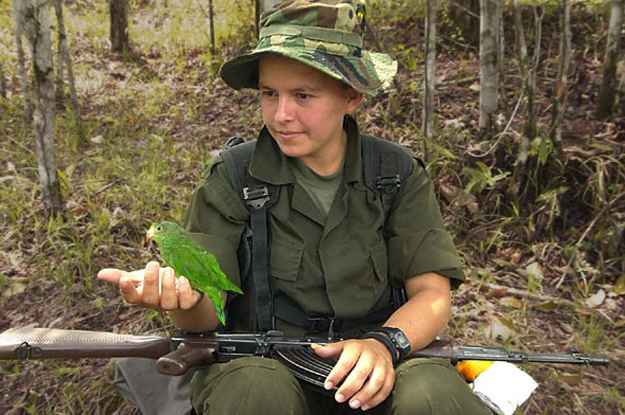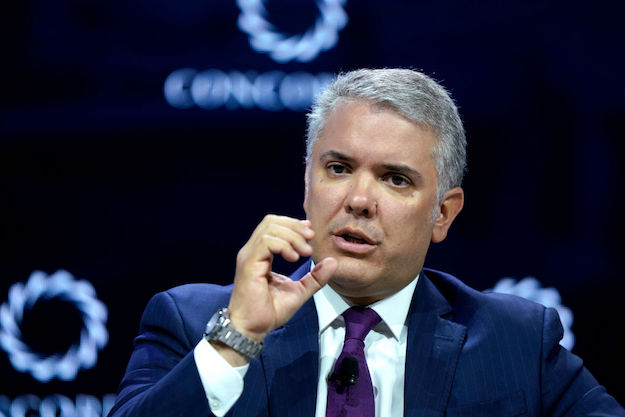They may call themselves the “generation of peace,” but young Colombians are actually among those least likely to support their government’s recent peace agreement with FARC rebels, which will be put to a plebiscite vote on October 2. Part of the reason, observers say, is that many young Colombians have not experienced the conflict as directly as their older compatriots.
But there is a portion of the youth population in Colombia that has had as close a view of the war as anyone: namely, those that have been fighting in it.
The FARC is not the only armed group in Colombia to have recruited child soldiers, but it is one of the worst offenders. Between 1979 and 2014, the group added more than 11,500 children under 18 to its ranks.
On September 10, as a trust-building measure ahead of the signing of peace accords on September 26, the FARC released 13 soldiers under 15 years old to international aid groups. They are expected to soon free the rest of their soldiers under 15 (the FARC claims there are 21, though the government counts at least 170) and, eventually, do the same with all soldiers under 18. After laying down their arms, they will join the thousands of former child soldiers in Colombia who have demobilized over the course of the 52-year conflict.
This represents the first step in a long process of reintegration that is designed to help youth transition to a normal life, and comes amid concerns that the issues that former youth combatants deal with may not be adequately understood by Colombian society as a whole.
“They feel singled out,” said Juliana Castellanos, who conducted field research into the impact of the FARC conflict in schools. “And the discrimination comes more from the parents than from other kids.”
The way their surroundings keep reminding them that they’re different is counterproductive to their reintegration process, Castellanos told AQ. Her research included asking children who are already in a reintegration program to write down what they feel and what they hear from their peers.
“I go into the classroom and everyone looks at me weirdly. I sit at my desk and I hear murmurs that say ‘He was a guerrilla fighter. How horrible. How many people could he have killed,’” one child wrote. “I feel like I’m in a world where I can’t adapt and no one will love me,” wrote another.
Similar feelings are still present for Diana, 28, a former guerrilla who is now studying for a law degree. Diana, who asked to be identified by her first name, grew up in a small town that was once a stronghold of the FARC. She joined the group voluntarily when she was 12 after she was unable to find a nearby public high school to attend. “FARC members…were well dressed, they looked like they had a good living, with their uniforms and their arms,” she told AQ via Skype.
Diana fled the group eight years later, enrolled in a reintegration program and went back to school. She is happy now, she said, but generally avoids telling people about her former life. “I have a fear of being rejected, of not getting a job, of not being loved. It’s complicated,” she said.
Those feelings of isolation may limit how effective reintegration programs can be for youth trying to put their pasts behind them. Studies from the University of the Andes in Bogotá show that the risk for relapse among minors is greater than it is for older combatants. In Colombia, where criminal and other armed groups continue to operate even as the FARC begins to demobilize, the risk of children falling back into violence is no small threat.
This is partly why the reintegration process for minors has been developed separately from the larger program, according to Leila Zerrougui, a UN special representative for children and armed conflicts. “(Reintegrating children) will not be easy, but it is worth it because you cannot ensure sustainability of this agreement and the end of over 50 years of conflict without dealing with the children, and even with the parents,” Zerrougui told AQ.
Under the terms of the agreement to be voted on this Sunday, child combatants will generally be treated as victims of the conflict, rather than its perpetrators. The government will offer education, health coverage and housing to minors under 18 who lay down arms. Youth under 14 will not be held responsible for any crimes committed, while those between 14 and 18 who have committed non-pardonable crimes will be examined on a case-by-case basis.
The child soldiers being handed over by the FARC will be received and evaluated by international organizations such as the Red Cross. Once they return home (or to alternative housing), they will come under the protection of the Colombian Institute for Family Welfare (ICBF), a government entity that received and monitored 5,850 former child soldiers between 1999 and 2015. Only when they turn 18 will minors be placed under the protection of the Colombian Reintegration Association.
The Colombian government hopes that these steps will help ease young people’s return to civilian life. For Diana, the prospect of a successful peace process would represent an opportunity to be more open about her past, and perhaps to serve as an example for children whose experience is similar to her own.
“I would be able to say it head on. Say that I made a mistake, but that here I am.”
—
Krygier is an editorial intern for Americas Quarterly.








